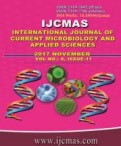


 National Academy of Agricultural Sciences (NAAS)
National Academy of Agricultural Sciences (NAAS)

|
PRINT ISSN : 2319-7692
Online ISSN : 2319-7706 Issues : 12 per year Publisher : Excellent Publishers Email : editorijcmas@gmail.com / submit@ijcmas.com Editor-in-chief: Dr.M.Prakash Index Copernicus ICV 2018: 95.39 NAAS RATING 2020: 5.38 |
The data are derived from daily maximum temperatures recorded at AEC&RI, Kumulur Meterological Observatory. Extreme maximum temperature using 25 years of data is studied. The maximum temperatures are modelled using the generalized extreme value distribution. The results showed that twenty five year maximums are significant to be fitted to the GEV model and thus are used as our selection periods. The Mann-Kendall test detects no monotonic trends for the maximum temperatures. The Kwiatkowski- Phillips-Schmidt-Shin test indicates that the data are stationary. Parameter values are estimated using the method of maximum likelihood. Both the Kolmogorov-Smirnov and Anderson-Darling goodness of fit tests show that the GEV distribution gives reasonable fit to the maximum quarterly temperatures. Estimates of the T-year return levels for the return periods 5, 10, 25, 50, 100, 110 and 200 years reveal that the air temperature for the AEC&RI Kumulur will be increasing over the next 200 years.
 |
 |
 |
 |
 |